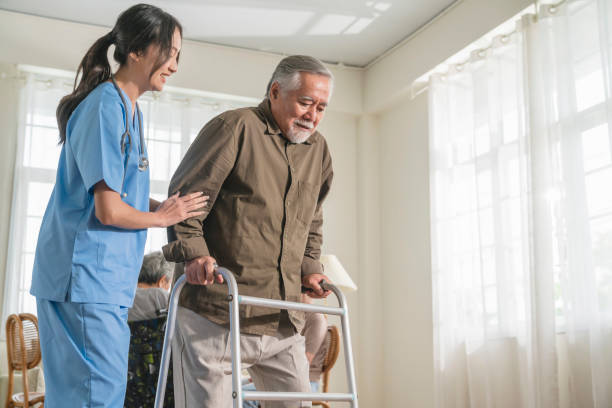As people age, changes in posture, bone density, muscle strength, and flexibility often lead to discomfort in the neck and back. Degenerative conditions such as arthritis, spinal stenosis, or herniated discs become more common, while years of wear and tear can cause chronic stiffness. Even simple daily activities—such as bending, lifting, or sitting for extended periods—may exacerbate these areas.
The result is that many older adults live with persistent pain that limits mobility, independence, and overall quality of life. Fortunately, physical therapy offers targeted solutions that go beyond temporary relief, helping address both the symptoms and root causes.
Contents
- 1 How Physical Therapy Targets Pain at Its Source
- 2 Restoring Strength and Flexibility
- 3 Correcting Posture and Movement Patterns
- 4 Hands-On Techniques That Bring Relief
- 5 Education and Self-Management for Long-Term Results
- 6 The Broader Benefits of Physical Therapy
- 7 When to Consider Physical Therapy
- 8 A Gentle but Powerful Path to Relief
How Physical Therapy Targets Pain at Its Source
Unlike quick fixes such as painkillers or injections, physical therapy is designed to treat the underlying factors that contribute to discomfort. A physical therapist begins with a thorough assessment, identifying issues such as weak muscles, poor posture, joint stiffness, or restricted movement patterns. From there, they create a customized plan that addresses the individual’s unique needs.
Therapy typically involves a blend of hands-on treatment, guided exercise, and education. Over time, these strategies not only reduce pain but also improve strength and flexibility, making it easier for older adults to move without discomfort.
Restoring Strength and Flexibility
Muscle weakness is one of the leading contributors to back and neck pain in seniors. As muscles lose strength, the spine and joints are forced to carry more stress, leading to strain and irritation. Physical therapists prescribe exercises that rebuild strength in the core, back, and shoulders—muscle groups that play a vital role in spinal support.
Flexibility is just as important. Gentle stretching routines improve range of motion, reduce stiffness, and ease the tension that builds in aging muscles. Restoring strength and flexibility together helps stabilize the spine, prevents further injuries, and provides lasting relief.
Correcting Posture and Movement Patterns
Poor posture, often developed over decades, is a major source of pain in the neck and back. Many older adults experience rounded shoulders, forward head positioning, or exaggerated spinal curves, all of which put strain on muscles and joints. Physical therapy corrects these imbalances through posture training and realignment exercises.
Therapists also teach safer movement techniques for everyday activities, such as lifting groceries, getting out of bed, or reaching overhead. By learning how to move properly, older adults reduce strain and prevent recurring pain.
Hands-On Techniques That Bring Relief

Beyond exercise, physical therapy often incorporates manual techniques to ease discomfort. Therapists may use gentle joint mobilization to improve spinal alignment, soft tissue massage to reduce muscle tension, or heat and cold therapy to calm inflammation. Some individuals may also benefit from electrical stimulation or ultrasound therapy to promote healing and reduce pain signals.
These hands-on methods provide immediate relief, while exercise and posture correction ensure long-term improvements. Together, they create a comprehensive approach to managing neck and back pain.
Education and Self-Management for Long-Term Results
One of the most powerful aspects of physical therapy is the emphasis on education. Older adults learn about the causes of their pain, strategies to manage flare-ups, and techniques to maintain progress at home. This might include daily stretching routines, ergonomic tips for sitting and sleeping, or safe ways to stay active.
By empowering individuals with knowledge, physical therapy reduces reliance on medications and equips older adults with tools to manage pain independently.
The Broader Benefits of Physical Therapy
While the immediate goal may be pain relief, the ripple effects of physical therapy extend much further. Improved mobility allows older adults to engage more fully in social activities, household tasks, and recreational hobbies. Increased strength lowers the risk of falls, a major concern for seniors. Even mental health benefits are significant—reduced pain and greater independence often lead to higher confidence, better sleep, and less anxiety.
For many, physical therapy is the key to maintaining not just physical comfort, but also dignity and freedom in daily life.
When to Consider Physical Therapy
Older adults experiencing ongoing neck or back pain that interferes with walking, sleeping, or performing everyday tasks should consider consulting a physical therapist. It’s also highly recommended for those recovering from spinal surgery, injuries, or extended periods of inactivity.
Since therapy plans are highly personalized, individuals can expect a treatment path that matches their current fitness level and health status. The focus is always on safe, progressive improvement.
A Gentle but Powerful Path to Relief
Neck and back pain do not have to be accepted as an inevitable part of aging. Through a careful blend of exercise, posture correction, manual therapy, and education, physical therapy offers older adults a proven path toward comfort and independence. Rather than masking symptoms, it equips them with the strength, mobility, and confidence to continue enjoying life on their own terms.
